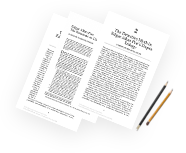For this assignment, you will prepare a written document that differentiates between the steps in conducting policy analysis. Please follow the instructions below and prepare your document. Be sure to save in .doc or .docx format, and to follow APA guidelines.
Expert Solution Preview
Introduction:
Policy analysis is a crucial process that involves identifying, evaluating, and recommending policy options to address societal issues. It requires a systematic approach and the application of rigorous analytical methods. In this written document, I will differentiate between the steps involved in conducting policy analysis.
Answer:
Conducting policy analysis involves several distinct steps that contribute to a comprehensive evaluation of potential policy options. These steps encompass a structured framework that guides researchers and analysts in the process. The following are the key steps in conducting policy analysis:
1. Problem Identification: The initial step in policy analysis is identifying the problem or societal issue that requires attention. This involves recognizing the existence of an issue, understanding its causes and consequences, and determining its significance. Accurate problem identification is crucial for ensuring that policy solutions effectively address the root cause.
2. Policy Formulation: Once the problem is identified, the next step is formulating potential policy solutions. This involves brainstorming and developing a range of possible policy options to address the identified problem. This step requires creativity and expertise in understanding the complexities of the issue at hand.
3. Policy Analysis: After formulating potential policy options, a detailed analysis of each option is conducted. This analysis involves examining the feasibility, effectiveness, and efficiency of the policy options. Various tools and techniques, such as cost-benefit analysis, stakeholder analysis, and impact assessment, may be employed to assess the potential outcomes and implications of each policy.
4. Policy Recommendations: Based on the analysis conducted, policy recommendations are then formulated. These recommendations outline the preferred policy option(s) that are deemed most effective, efficient, and feasible for addressing the identified problem. The recommendations should be evidence-based and consider the broader context and potential consequences.
5. Policy Implementation: Once policy recommendations are made, the next step is their implementation. This involves translating the recommended policy into action. It requires coordinating various stakeholders, ensuring resource availability, and developing an implementation plan. Monitoring and evaluation mechanisms are crucial during the implementation phase to track progress and make necessary adjustments.
6. Policy Evaluation: After policy implementation, an evaluation is conducted to assess its impact and effectiveness. This step involves analyzing whether the policy has achieved its intended outcomes, considering both the positive and negative consequences, and identifying areas for improvement. Policy evaluation provides valuable insights for refining existing policies and informing future policy decisions.
It is important to note that policy analysis is an iterative process, and these steps are not necessarily sequential. Feedback and adjustments may be made throughout each stage to enhance the quality of analysis and decision-making.
In conclusion, conducting policy analysis requires a systematic approach involving problem identification, policy formulation, policy analysis, policy recommendations, policy implementation, and policy evaluation. Each step contributes to a thorough understanding of the issue at hand and helps in formulating effective and evidence-based policies for addressing societal problems.




